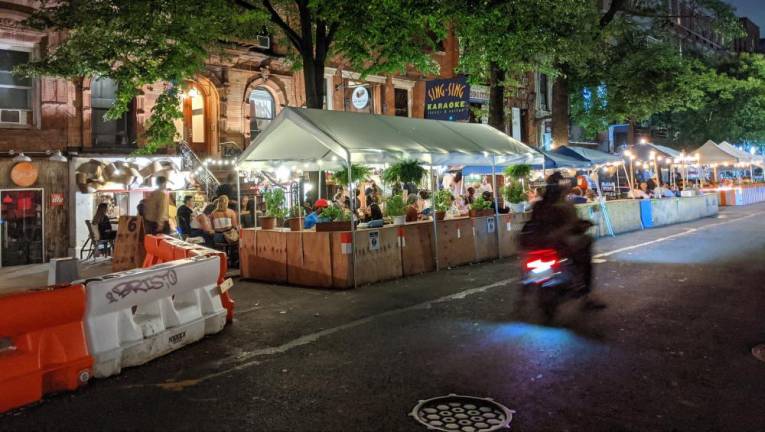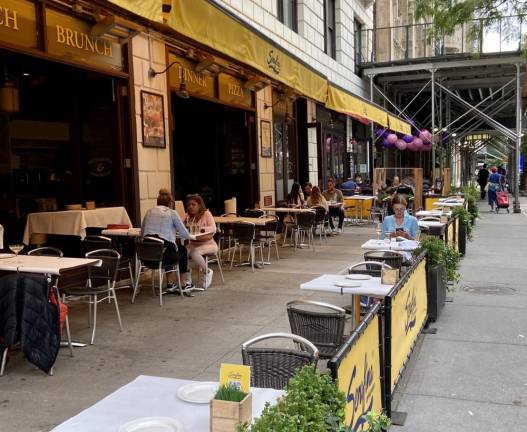There is no path to recovery for New York that does not pass through our love for dining out. Whether indoors or out, for breakfast, lunch or dinner — to say nothing of the fabled New York brunch — eating is more than a pastime, an entertainment or a business obligation.
It is one of the city’s biggest industries.
Or it was. In August of 2019, 318,000 New Yorkers were employed in restaurants and bars. This August, it was 174,000; a horrifying 44 percent collapse (and, by the way, this isthe comeback from the depths of the lockdown in April when only 91,000 restaurant workers were on the job).
“It’s a dire situation with no end in sight,” said the industry’s chief spokesman, Andrew Rigie, Executive Director of the New York City Hospitality Alliance.
For perspective, a year ago another major industry of roughly similar size (but generally better pay), insurance and finance, employed 355,000 people. In August of this year it was 335,000, as most employees were able to work from home.
You can’t wait tables from home, the restaurant industry stresses.“We will need ongoing support from all levels of government to give as many restaurants as possible a chance of survival,” Rigie said.
Two major lifelines were tossed out in recent days.
Mayor Bill de Blasio announced last week that outdoor dinning — one of the more successful adaptations to the pandemic with 10,000 restaurants participating — would be permitted permanently and year round. Restaurants will even be allowed to install heaters outside to take the winter chill off al fresco — an irony since Paris, the city of light and outdoor cafes, had announced a pre-pandemic plan to ban heaters as part of its push to decarbonize.
The Mayor’s announcement of permeant outdoor dining coincides with the resumption of indoor dining this week, but only at 25 percent of pre-pandemic seating capacity. By November, restaurants hope to be back to 50 percent capacity indoors if all goes well, which, with infection rates climbing again, is no sure thing.
“This doesn’t alone save restaurants,” Rigie said. “When restaurants had 100 percent indoor dining it was challenging.”
Nothing in New York is easy, that’s for sure.
Rigie points out that no restaurateur can make a living on 25 percent usage, certainly not while paying 100 percent for rent and other costs. And while outdoor dining has been a big success, less than half of the city’s 25,000 eating and drinking establishments have participated.
A survey by Rigie’s Hospitality Alliance found that 87 percent of his members who responded reported they had been unable to pay their full rent in August, up from 80 percent the month before. A third said they had paid no rent at all.
In other words, the restaurant crisis is cascading back up the financial chain into a rent crisis for many commercial landlords.
No Recovery Plan
Given how central dining out is to both jobs and real estate in New York it was puzzling how the mayor last week separated his announcement on outdoor dining from unveiling his “framework” for New York City’s recovery.
The mayor announced four “core principals” for recovery. They are continued efforts to contain the virus; a focus on public health research as a growth industry; creating “high quality jobs” and making sure low income and minority communities, which bore the brunt of the pandemic, are fully served. Details, he said, would be forthcoming in the weeks ahead.
The press, reflecting a loss of patience with the mayor shared by many New Yorkers, was merciless. “De Blasio still has no coronavirus recovery plan for New York City,” cried the Post. The New York Times did something even harsher. They ignored him.
What the mayor seems not to have absorbed about the situation is that plans and principles are all well and good, but recovery, like God, is in the details. His restaurant plans contain important details that begin to make it possible to visualize what a post-Covid19 New York could be like, at least on the topic of dining out.
Ginia Bellafante, one of the few remaining New York voices at The New York Times, noted that allowing heaters was of limited use when pandemic buying has made them scarce. What is needed is a major Skunkworks to design wintertime outdoor dining solutions for New York eateries.
To dramatize, and glamorize, her point, Bellafante’s editors ran a picture of Audrey Hepburn eating at an outdoor restaurant in the Alps from the movie Charade.
“Instead of leaving individual restaurant owners to figure these things out on their own, as if they were in a live-or-die episode of ‘Top Chef’,” Bellafante wrote, “the city should lead a major effort to make outdoor dining in winter work for everybody.”
This effort should draw on talents from urban planners and landscape architects to “fashion designers, makers, manufacturers, graphic designers, task rabbits and so on,” she wrote.
“Short of a successful vaccine fully delivered before Halloween or another significant round of federal subsidies, creating a viable means of outdoor dining and promoting it is really the only way to prevent the restaurant industry from collapsing.”
“We will need ongoing support from all levels of government to give as many restaurants as possible a chance of survival,” Andrew Rigie, Executive Director of the New York City Hospitality Alliance.

